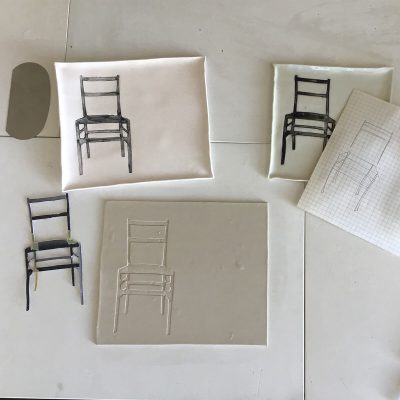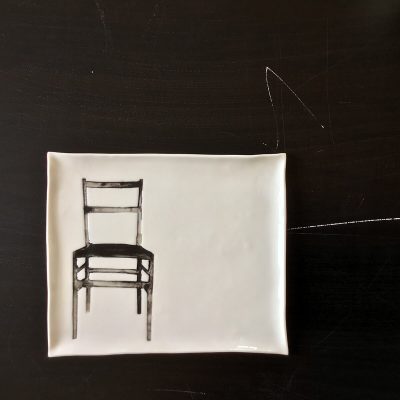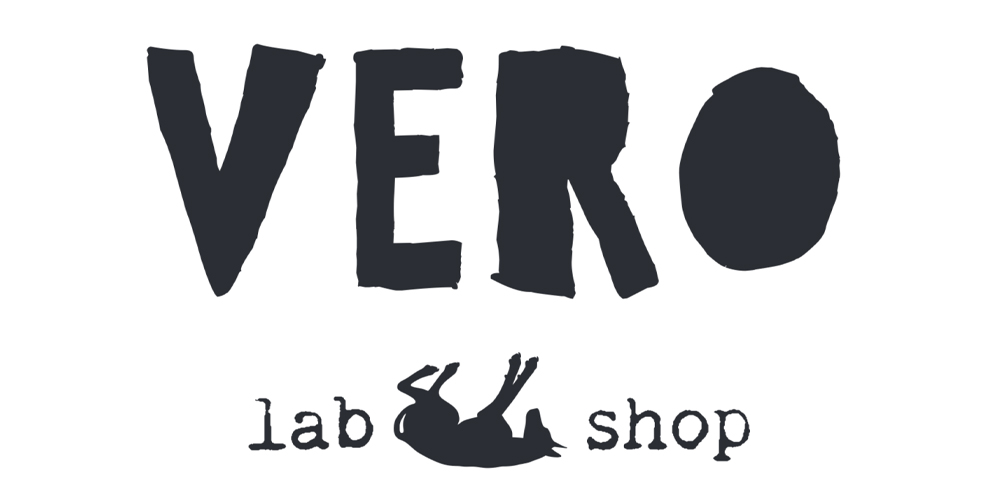“I’ve always believed that extraordinary things can happen in life. It happened to me with porcelain.
In 2015 I started the production of my porcelain … I still remember the satisfaction of looking at my first “perfect” cup!
After a thousand attempts, errors and trials, I have become familiar with the subject and over time I have increased my technical confidence. Working with porcelain is a tough choice, because of all ceramics it is the most precious and elegant one. The only translucent one, and the most difficult, too.
To create a handcrafted object in porcelain it takes at least 10 working days. A long job, which requires about ten steps, as well as two firings: the second one reaches a temperature of 1250 degrees centigrade. Each step of the birth of an object requires experience, sensitivity, and precision.
This is why I have learned to value failure too, not to lose patience in the face of negative results.
Indeed, mistakes become an opportunity for me to look for the right path, through beauty and lightness.
Southern Ice porcelain is one of the finest and whitest porcelain on the market. An important aspect that led me to choose this material is the guarantee that the manufacturer has given me not to use bone ash, an ingredient typically used in Bone China porcelain. This aspect is essential to me, as I am a vegetarian by ethical choice; I love animals and do not tolerate the exploitation of intensive farming. The colour and the high translucency (the porcelain is the only translucent among all the ceramics, the light passes through it in a diffused way, it is not transparent, but if you look at it in counter light you see it passes!) are due to the care in the choice of the ingredients and to the extreme purity of the Australian raw materials.
Porcelain is a material that cooks at high temperatures and therefore is valuable and very resistant, is not porous, is suitable for food use and can be washed in the dishwasher”, Veronica Vianini – Founder of Verolba.
Why it is in The Green Circle
Every time I enter a museum and see the section dedicated to archaeological finds, I notice that the majority of the items are made of clay, still intact after centuries, and I think: creating ceramic objects is a great responsibility because once made and put into circulation, they become part of this earth. For this reason, I try to have the utmost respect for the environment! Starting from my workshop, always clean and tidy and without waste of material, so much so that nothing is thrown away but almost everything is reused, transformed. My artisanal production is conscious and never mass-produced; I even try to sell my pieces to clients or retailers who are truly fascinated by porcelain, so as to envision an emotional rather than utilitarian and standardised use. The search for raw material, namely the porcelain and stoneware clays, always has a special regard for the origin, sometimes I favored vegan ceramics and then moved elsewhere, but only because the vegan ones come from Australia and therefore the very long transport journey and impact on the planet left me a bit perplexed in my philosophy of respect for the environment. I am always very careful not to use glazes or materials that may contain heavy metals and do not use gold and silver to avoid a poisonous contamination of the kiln that would require subsequent firings to counteract the presence of toxic molecules, where a whole load of white objects would have to absorb and then be discarded as special waste. The life I lead, in general, favors simplicity, I have been using the same utility car for 12 years, every item used even for shipping and packaging tries to avoid plastic as much as possible, preferring paper.
SDGs: 3, 4, 6, 7, 8, 11, 12, 13, 14, 15
-

 White porcelain, in the upper part shiny, in the lower part opaque, without crystalline but satin and pleasant to the touch. It has a shape that captivates souls of all latitudes, genres, and cultures. Mixing coffee with this teaspoon creates a beautiful contrast between the bitterness of the drink and the sweetness of sugar, sweet as love! Maybe that's why it has great success!
White porcelain, in the upper part shiny, in the lower part opaque, without crystalline but satin and pleasant to the touch. It has a shape that captivates souls of all latitudes, genres, and cultures. Mixing coffee with this teaspoon creates a beautiful contrast between the bitterness of the drink and the sweetness of sugar, sweet as love! Maybe that's why it has great success! -

 Shiny white porcelain. It's a saucer, a tray, or an object to put on a table. It reproduces the Superleggera chair by Giò Ponti in bas-relief, a tribute to lightness. This tray is also coloured dry with a black pigment. In the artist's will, lightness is an important theme; he searches for it, dreams of it, and sometimes live it... it is not superficiality, as Italo Calvino used to say, but it is to glide over things from above, not to have boulders on the heart.
Shiny white porcelain. It's a saucer, a tray, or an object to put on a table. It reproduces the Superleggera chair by Giò Ponti in bas-relief, a tribute to lightness. This tray is also coloured dry with a black pigment. In the artist's will, lightness is an important theme; he searches for it, dreams of it, and sometimes live it... it is not superficiality, as Italo Calvino used to say, but it is to glide over things from above, not to have boulders on the heart. -

 Shiny white porcelain. The leaf is in bas-relief, perfect in the veins because it is the expression of a real sage leaf, which is impressed on the porcelain sheet as you shape the object. Once dry, the leaf is coloured with a black pigment mixed with water: precision work that gives excellent results!
Shiny white porcelain. The leaf is in bas-relief, perfect in the veins because it is the expression of a real sage leaf, which is impressed on the porcelain sheet as you shape the object. Once dry, the leaf is coloured with a black pigment mixed with water: precision work that gives excellent results! -

 The name recalls a famous biscuit born in the last century; it is an opaque plate made of white porcelain combined with black porcelain. The textures are created with '90s rubber samples recovered from old samples and used to imprint reliefs on objects. The opaque ceramic plate is designed as a tray. As it is made of porous ceramic, it can be used as a serving plate for dry, non-greasy or coloured dishes.
The name recalls a famous biscuit born in the last century; it is an opaque plate made of white porcelain combined with black porcelain. The textures are created with '90s rubber samples recovered from old samples and used to imprint reliefs on objects. The opaque ceramic plate is designed as a tray. As it is made of porous ceramic, it can be used as a serving plate for dry, non-greasy or coloured dishes.








